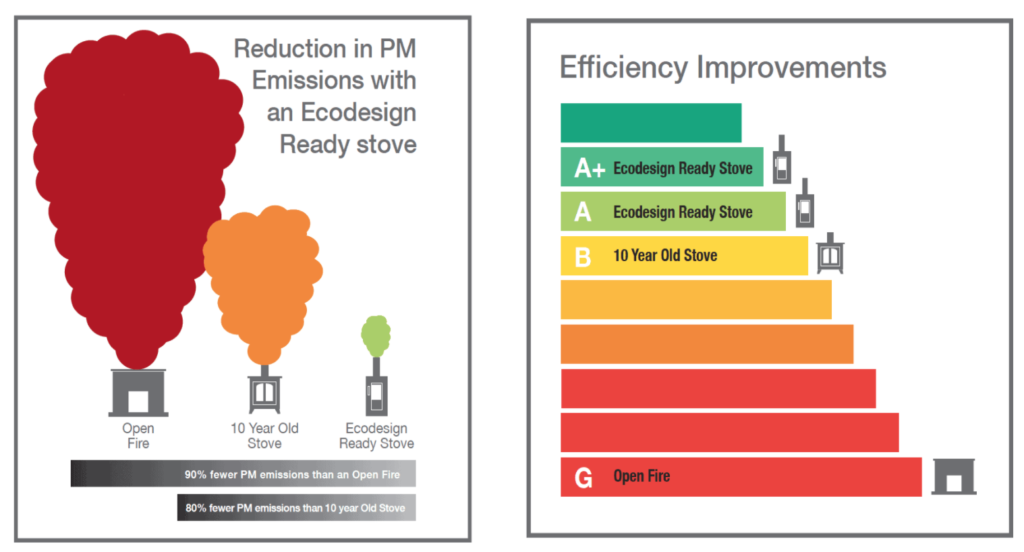Next month will mark 70 years since the Great Smog of London. In December 1952, a period of cold weather combined with a lack of wind caused airborne particles, mostly from burning coal on open fires, to form a thick layer of smog over the city. The Great Smog was short-lived but highly destructive. From 5th to 9th December, the smog took an estimated 4,000 lives as a direct result, and more than 100,000 were made ill from the effects of the smog.

Fast forward 70 years…..
While things have vastly changed since 1952, sadly, air pollution still exists, albeit to a much lesser degree. However, due to the cost of living crisis, air pollution is expected to increase as people start to use open fires to keep warm in a bid to save on energy costs.
It’s important to note that burning wood can be a very environmentally friendly way to keep warm as long as you use the right appliance and burn the right wood.
Not all fires are created equal
This expected increase in air pollution, should it arise, will be down to:
* Burning inappropriate items (such as wet wood, rubbish, treated/painted furniture, coal etc.)
* Using either an open fire or an old, inefficient non-Ecodesign stove.
When correctly seasoned wood is burnt in an Ecodesign stove, emissions are significantly lower. The diagram below shows just how clean Ecodesign stoves are.

Not only are Ecodesign stoves more environmentally friendly, but you also burn less wood for the same amount of heat. Burning rubbish or anything deemed unsuitable is irresponsible and potentially dangerous; it will also give a poor heat output.
Using dry/seasoned wood will help ensure a better burn, fewer emissions, and a fire, which is much easier to light. Freshly cut wood will have a moisture content of 50% or more. For correctly seasoned wood, this figure is closer to 20%. Since 1st May 2021, the government has been phasing out the sale of wet/unseasoned wood in small volumes (under 2m3) in England. This is part of the successful The Ready to Burn initiative.
If you burn 10kg of dry wood with a moisture content of 20%, then you have evaporated 2kg of water. With logs containing a moisture content of 50%, you would evaporate 5kg of water (and cause lots more pollution). The wasted energy of having to evaporate the additional water impacts a fire’s performance and costs you more in the long run.
Chimney Sweeps:
Who would have thought that in 2022 the demand for chimney sweeps would be rocketing? But this is the case in many areas around the UK. With so many people burning wood, there is an increased demand for chimney sweeps. Making sure your chimney is swept every few months during active periods is essential to safeguard the stove’s efficiency and reduce the chances of chimney fires occurring.
The Stove Industry Alliance (SIA), whose members (including Charlton & Jenrick) account for 75% of UK stove sales, reported a 40% increase in sales between April and June 2022, which is a considerable increase from up from a year earlier.
Free Tips:
Here are our top 5 essential tips for burning wood.
#1 Always burn the best fuel you can afford. Hardwood logs are the best and can be bought kiln-dried ready for use.
#2 For maximum safety, always fit a CO (Carbon Monoxide) detector in the same room as a solid fuel combustion appliance of any kind.
#3 Don’t slumber your stove (burning very slowly) as a habitual operating method. The smoke and chemicals that can be released will shorten the life of the stove itself, the chimney, and particularly flue liners.
#4 Reduce the amount of smoke, and keep the glass of your stove cleaner during ignition, by using the top-down ignition method. Put two small-diameter logs on the grate of the stove, two further logs crossed over the first pair, followed by a firelighter and a “Jenga” style criss-cross crib of kindling on top. The wood must be fully dry, but once the fire lights, it should burn down to the base logs and be ready for the next fuel load with little intervention.
#5 The best fuel for stoves is hardwood logs having no more than 20% moisture content for the best burn. Kiln-dried or seasoned work equally as well, but they must be seasoned long enough to achieve low moisture levels.
When you burn wood, you need to be responsible and be aware that you just can’t throw any old rubbish on it. Once you know what to burn and how to burn it, you will enjoy clean, cheap, efficient heat for your home.







